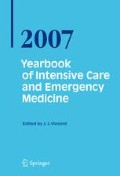Abstract
Mechanical ventilation delivers pressure, flow, and/or volume to the patient with the aim of improving ventilation and reducing inspiratory work. Depending on various circumstances, such as the level of sedation, paralysis, or if the ventilator support is patient triggered or not, the goals of mechanical ventilation (improved ventilation and reduced work of breathing) may be achieved in different ways.
Access this chapter
Tax calculation will be finalised at checkout
Purchases are for personal use only
Preview
Unable to display preview. Download preview PDF.
References
Younes M (1992) Proportional assist ventilation, a new approach to ventilatory support: Theory. Am Rev Respir Dis 145:114–120
Leung P, Jubran A, Tobin MJ (1997) Comparison of assisted ventilator modes on triggering, patient effort, and dyspnea. Am J Respir Crit Care Med 155:1940–1948
Calderini E, Confalonieri M, Puccio PG, Francavilla N, Stella L, Gregoretti C (1999) Patientventilator asynchrony during noninvasive ventilation: the role of expiratory trigger. Intensive Care Med 25:662–667
Brack T, Jubran A, Tobin MJ (2002) Dyspnea and decreased variability of breathing in patients with restrictive lung disease. Am J Respir Crit Care Med 165:1260–1264
Wysocki M, Cracco C, Teixeira A, et al (2006) Reduced breathing variability as a predictor of unsuccessful patient separation from mechanical ventilation. Crit Care Med 34:2076–2083
Parthasarathy S, Jubran A, Tobin MJ (1998) Cycling of inspiratory and expiratory muscle groups with the ventilator in airflow limitation. Am J Respir Crit Care Med 158:1471–1478
Van de Graaff WB, Gordey K, Dornseif SE, et al (1991) Pressure support. Changes in ventilatory pattern and components of the work of breathing. Chest 100:1082–1089
Duffin J, Mohan RM, Vasiliou P, Stephenson R, Mahamed S (2000) A model of the chemoreflex control of breathing in humans: model parameters measurement. Respir Physiol 120:13–26
Burchardi H (2004) Aims of sedation/analgesia. Minerva Anestesiol 70:137–143
Shook JE, Watkins WD, Camporesi EM (1990) Differential roles of opioid receptors in respiration, respiratory disease, and opiate-induced respiratory depression. Am Rev Respir Dis 142:895–909
Forster A, Gardaz JP, Suter PM, Gemperle M (1980) Respiratory depression by midazolam and diazepam. Anesthesiology 53:494–497
Bouillon T, Bruhn J, Radu-Radulescu L, Andresen C, Cohane C, Shafer SL (2004) Mixedeffects modeling of the intrinsic ventilatory depressant potency of propofol in the non-steady state. Anesthesiology 100:240–250
Grasso S, Fanelli V, Cafarelli A, et al (2004) Patient ventilator interaction during PSV at different levels of sedation in ALI patients. Intensive Care Med 30:S13 (abst)
Beck J, Tucci M, Emeriaud G, Lacroix J, Sinderby C (2004) Prolonged neural expiratory time induced by mechanical ventilation in infants. Pediatr Res 55:747–754
Beck J, Gottfried SB, Navalesi P, et al (2001) Electrical activity of the diaphragm during pressure support ventilation in acute respiratory failure. Am J Respir Crit Care Med 164:419–424
Younes M, Kun J, Webster K, Roberts D (2002) Response of ventilator-dependent patients to delayed opening of exhalation valve. Am J Respir Crit Care Med 166:21–30
Greenough A, Milner AD, Dimitriou G (2004) Synchronized mechanical ventilation for respiratory support in newborn infants. Cochrane Database Syst Rev 4:CD000456
Navalesi P, Hernandez P, Wongsa A, Laporta D, Goldberg P, Gottfried SB (1996) PAV in acute respiratory failure: effects on breathing pattern and inspiratory effort. Am J Respir Crit Care Med 154:1330–1338
Sinderby C, Navalesi P, Beck J, et al (1999) Neural control of mechanical ventilation in respiratory failure. Nat Med 5:1433–1436
Lourenco RV, Cherniack NS, Malm JR, Fishman AP (1966) Nervous output from the respiratory centers during obstructed breathing. J Appl Physiol 21: 527–533
Parthasarathy S, Jubran A, Tobin MJ (2000) Assessment of neural inspiratory time in ventilator-supported patients Am J Respir Crit Care Med 162:546–552
Singh B, Panizza JA, Finucane KE (2005) Diaphragm electromyogram root mean square response to hypercapnia and its intersubject and day-to-day variation. J Appl Physiol 98:274–281
Allo JC, Beck JC, Brander L, Brunet F, Slutsky AS, Sinderby CA (2006) Influence of neurally adjusted ventilatory assist and positive end-expiratory pressure on breathing pattern in rabbits with acute lung injury Crit Care Med 34:2997–3004
Sinderby C, Beck J, Spahija J, et al (2007) Inspiratory muscle unloading by neurally adjusted ventilatory assist during maximal inspiratory efforts in healthy subjects. Chest (in press)
Author information
Authors and Affiliations
Rights and permissions
Copyright information
© 2007 Springer Science + Business Media Inc.
About this paper
Cite this paper
Sinderby, C., Brander, L., Beck, J. (2007). Is One Fixed Level of Assist Sufficient to Mechanically Ventilate Spontaneously Breathing Patients?. In: Intensive Care Medicine. Yearbook of Intensive Care and Emergency Medicine, vol 2007. Springer, Berlin, Heidelberg. https://doi.org/10.1007/978-3-540-49433-1_31
Download citation
DOI: https://doi.org/10.1007/978-3-540-49433-1_31
Publisher Name: Springer, Berlin, Heidelberg
Print ISBN: 978-3-540-49432-4
Online ISBN: 978-3-540-49433-1
eBook Packages: MedicineMedicine (R0)

